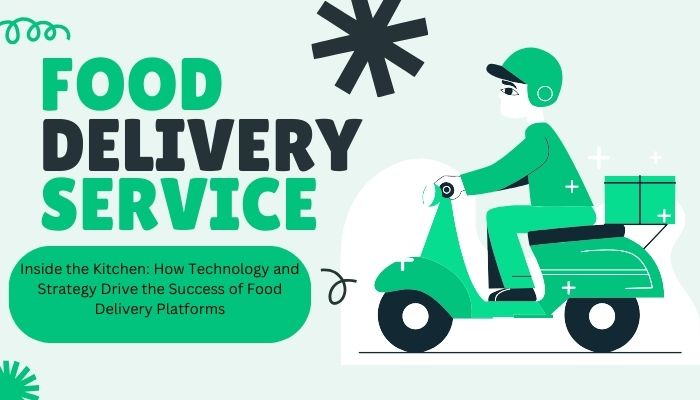How Technology and Strategy Drive the Success of Food Delivery Platforms
In the competitive world of food delivery, success hinges on more than just quick deliveries. This blog explores how leading platforms use cutting-edge technology and strategic planning. By leveraging advanced algorithms for delivery optimization, utilizing demand forecasting, and forming strategic partnerships, these platforms meet their targets and expand their market presence. Ultimately, the balance between operational efficiency, cost management, and customer satisfaction drives the long-term success of food delivery platforms. As the industry evolves, those that continue to innovate and focus on the customer experience will lead the way.

In today’s fast-paced world, online food delivery platforms have become indispensable, transforming how we dine with just a few taps on our phones. Behind the scenes, these platforms employ a sophisticated blend of technology, strategic partnerships, and customer-focused innovations to thrive in a highly competitive market. This blog delves into the key strategies that drive these platforms to success, exploring how they meet targets, adapt for survival, and elevate customer satisfaction.
Meeting Targets: A Data-Driven Approach
In a world where timing is everything, online food delivery platforms rely heavily on cutting-edge technology to meet their operational targets. At the core of their success lies a sophisticated network of algorithms designed to optimize delivery routes, ensuring that food reaches customers quickly and efficiently. These algorithms take into account various factors such as traffic patterns, order volumes, and rider availability to create the most effective delivery network possible.
Demand forecasting is another element by analyzing historical data and current trends, platforms can predict busy periods, allowing them to allocate resources more effectively. This predictive power extends to dynamic pricing strategies, where prices may fluctuate based on demand, time of day, or even weather conditions, ensuring that the platforms remain both competitive and profitable.
Partnerships with a wide range of restaurants and the establishment of cloud kitchens further enhance the platform's offerings and reach. These strategic alliances allow platforms to cater to a broader audience, offering diverse culinary options while also driving growth and market share. Additionally, targeted marketing campaigns and promotions play a crucial role in attracting new customers and retaining existing ones, reinforcing the platform’s position in the market.
Survival Strategies: Adapting to Change
In the fiercely competitive landscape of online food delivery, adaptability is key to survival. Many platforms have diversified their services to include grocery delivery and other on-demand services, which not only helps them weather fluctuations in the food delivery market but also opens up new revenue streams.
Cost optimization strategies are essential for long-term survival. These include setting up dark stores—fulfillment centers designed for quick delivery—and sharing delivery fleets across different services. Investing in automation, such as using AI for inventory management or automated kitchens, can also significantly reduce operational costs.
Customer retention remains a critical focus. Platforms employ loyalty programs, personalized recommendations, and exceptional customer service to keep users coming back. By fostering a sense of loyalty, platforms can ensure a steady stream of repeat orders, which is vital for sustaining growth and profitability in a crowded market.
.jpg)
Temperature-Controlled Delivery: Elevating the Experience
One of the most notable innovations in the food delivery industry has been the introduction of temperature-controlled packaging. This technology ensures that hot food stays hot and cold items remain chilled, thereby preserving the quality of meals during transit. This innovation has allowing users to enjoy restaurant-quality meals in their homes.
While this improvement significantly boosts customer satisfaction, it does come with challenges. Specialized packaging and equipment increase operational costs, and delivery times may be slightly longer to ensure that food quality is maintained. However, the positive impact on customer satisfaction and the likelihood of repeat orders often justify these investments.
The Customer Satisfaction Equation
While innovations like temperature control play a significant role in customer satisfaction, they are just one piece of the puzzle. Speed of delivery remains a top priority for most users, with platforms continually striving to reduce wait times. The quality of food upon arrival, including its presentation and the accuracy of the order, is equally important.
User-friendly apps and interfaces contribute significantly to the overall customer experience. Features like easy ordering processes, real-time tracking, and seamless payment options enhance user satisfaction and encourage repeat business. When issues arise, prompt and effective customer service is essential for maintaining customer loyalty and trust.
.jpg)
Looking Ahead: My Thoughts on the Future of Food Delivery
As the online food delivery industry continues to evolve, innovation will remain at the forefront. From the potential of drone deliveries to the growing use of AI-powered personalization, these platforms are set to push the boundaries of what’s possible. In my view, the platforms that will thrive are those that can strike a delicate balance between growth, profitability, and customer satisfaction.
Looking ahead, I believe the most successful platforms will be those that continue to prioritize customer experience, not just in terms of speed and convenience, but in delivering quality and maintaining transparency. The industry is moving towards more sustainable practices, and those that can incorporate these without compromising on customer satisfaction will lead the way. The ability to innovate while staying connected to customer needs will be the key to success in this rapidly changing landscape.
